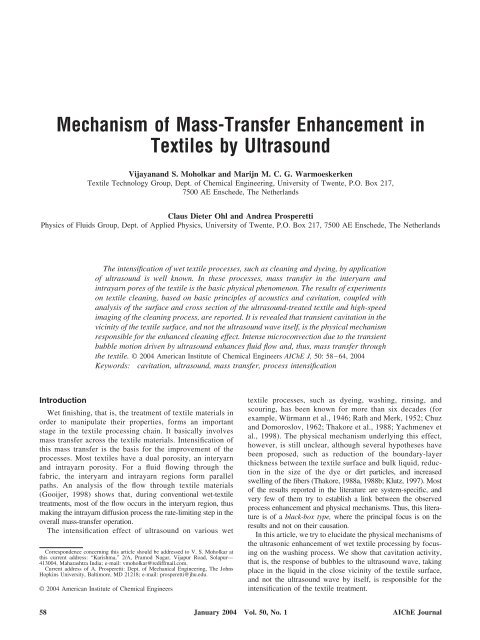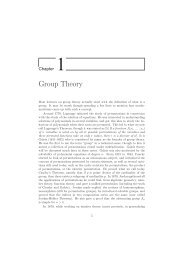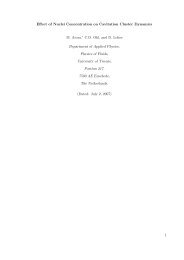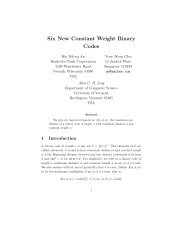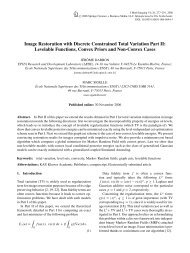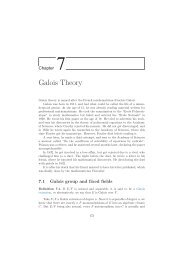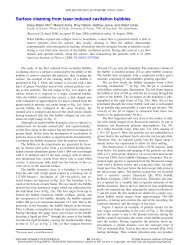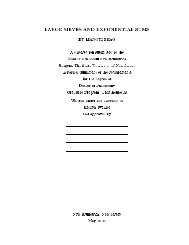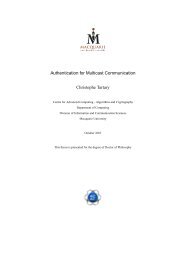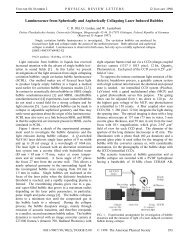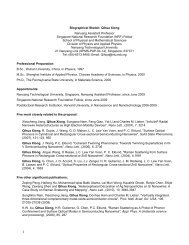Mechanism of mass-transfer enhancement in textiles by ultrasound
Mechanism of mass-transfer enhancement in textiles by ultrasound
Mechanism of mass-transfer enhancement in textiles by ultrasound
Create successful ePaper yourself
Turn your PDF publications into a flip-book with our unique Google optimized e-Paper software.
mounted on a thick sta<strong>in</strong>less steel bottom, act<strong>in</strong>g as a rigidreflector for the ultrasonic waves, with four vertical bars support<strong>in</strong>gthe glass r<strong>in</strong>gs placed above each other. The <strong>textiles</strong>ample could be placed <strong>in</strong> between the glass r<strong>in</strong>gs at differentdistances from the bottom, and the glass r<strong>in</strong>gs could be pressedtogether with the lid on top <strong>of</strong> the third r<strong>in</strong>g. Rubber gasketswere placed between the textile and the glass r<strong>in</strong>gs <strong>in</strong> order toavoid leakage. Pressure amplitude at the pressure node andant<strong>in</strong>ode was measured <strong>by</strong> a hydrophone (Brüel & Kaejer Ltd.,Type 8103). The <strong>ultrasound</strong> unit was an specially made hornwith a central resonance frequency <strong>of</strong> 25 kHz driven <strong>by</strong> a signalgenerator (Hewlett-Packard Inc., Model 3324A) and a radi<strong>of</strong>requency amplifier (ENI Inc., Model 2100L). It was mountedonto the shaft <strong>of</strong> a laboratory jack and the experimental cellwas placed on its base, which could be raised or lowered toadjust the distance between the bottom <strong>of</strong> the cell and the tip <strong>of</strong>the horn. The horn had a small circular groove <strong>in</strong> its tip, thesignificance <strong>of</strong> which will become apparent later. In order toconduct the experiments under raised static pressure, a highpressurevessel (volume: 40 L; max. work<strong>in</strong>g pressure: 10 bar)was constructed, which could accommodate the entire experimentalsetup. A stand<strong>in</strong>g-wave field was generated <strong>in</strong> theexperimental cell <strong>by</strong> adjust<strong>in</strong>g the distance between the sta<strong>in</strong>lesssteel bottom and the tip <strong>of</strong> the <strong>ultrasound</strong> horn equal to onewavelength () <strong>of</strong> <strong>ultrasound</strong>.Accord<strong>in</strong>g to the well-known properties <strong>of</strong> stand<strong>in</strong>g wavesfor plane-wave reflection (Pierce, 1989), pressure nodes occurat a distance <strong>of</strong> /4 and 3/4, while the pressure ant<strong>in</strong>odeoccurs at a distance <strong>of</strong> /2 from the rigid reflector. The <strong>ultrasound</strong>horn was driven at 25 kHz, with a power <strong>in</strong>put <strong>of</strong> 20 W.For this power <strong>in</strong>put, it produced an acoustic wave with pressureamplitude <strong>of</strong> 1.3 bar, which is above the transientcavitation threshold <strong>in</strong> normal water. The experiments weredivided <strong>in</strong>to four categories:(1) Nondegassed fabric and nondegassed wash<strong>in</strong>g medium(NDF-NDW);(2) Degassed fabric and nondegassed wash<strong>in</strong>g medium (DF-NDW);(3) Nondegassed fabric and degassed wash<strong>in</strong>g medium(NDF-DW);(4) Degassed fabric and degassed wash<strong>in</strong>g medium (DF-DW).Experiments <strong>in</strong> each one <strong>of</strong> these categories were carriedout at the pressure node and at the pressure ant<strong>in</strong>ode <strong>in</strong> thestand<strong>in</strong>g-wave field. Thus, there were eight sets <strong>of</strong> experiments<strong>in</strong> total. In addition, the static pressure <strong>of</strong> the experimentalsystem was varied and the eight sets <strong>of</strong> experimentspreviously mentioned were conducted at static pressures <strong>of</strong>1 (atmospheric), 2, 3, and 5 bar. S<strong>in</strong>ce denucleat<strong>in</strong>g gassywater is not entirely straightforward, experiments with denucleation<strong>of</strong> the wash<strong>in</strong>g medium could be carried out onlyfor categories NDF-DW and DF-DW, at the pressure ant<strong>in</strong>odeand the pressure node. In each set <strong>of</strong> experiments, threeruns were conducted with different pieces <strong>of</strong> the modelfabric <strong>in</strong> order to assess the reproducibility <strong>of</strong> the results.The carbon particles on the EMPA 101 fabric are not free tobe transported <strong>by</strong> convection, but adhere to the fiber alongwith the olive oil. These particles therefore need to beloosened from the surface <strong>of</strong> the fibers before be<strong>in</strong>g transported<strong>in</strong> the medium. Therefore, the fabric was soaked <strong>in</strong> adetergent solution (1.75 g/L <strong>of</strong> sodium dodecyl benzeneFigure 2. Trends <strong>in</strong> wash<strong>in</strong>g efficiencies <strong>in</strong> different categories<strong>of</strong> experiments.(A) Trends <strong>in</strong> wash<strong>in</strong>g efficiency at pressure ant<strong>in</strong>ode withvary<strong>in</strong>g static pressure; (B) trends <strong>in</strong> wash<strong>in</strong>g efficiency atpressure node with vary<strong>in</strong>g static pressure; (C) results <strong>of</strong> thewash<strong>in</strong>g experiments done with denucleation <strong>of</strong> the medium.sulfonate) for 5 m<strong>in</strong> before ultrasonic treatment so as toloosen the carbon particles from the surface <strong>of</strong> the fibers.Thus, the EMPA 101 fabric meets the criteria for the modelfabric and monitor (that the monitor should not form astrong bond with the textile fibers) after soak<strong>in</strong>g <strong>in</strong> a detergentsolution. Dur<strong>in</strong>g soak<strong>in</strong>g, the detergent solution waskept still <strong>in</strong> order to avoid the transportation <strong>of</strong> loosened soilaway from the fabric. Thus, soak<strong>in</strong>g <strong>of</strong> the fabric is notlikely to cause any major change to the <strong>in</strong>itial lightness <strong>of</strong>the fabric. In addition, all the textile samples were treated <strong>in</strong>exactly the same way, and hence, even if few carbon particleswere removed dur<strong>in</strong>g soak<strong>in</strong>g, this feature does notaffect the conclusions. In each experiment, 250 mL <strong>of</strong> waterwas used as the wash<strong>in</strong>g medium. The dissolved oxygencontent <strong>of</strong> the wash<strong>in</strong>g medium was 10 ppm for categoriesNDF-NDW and DF-NDW, while it was lowered to 2 ppmfor categories NDF-DW and DF-DW us<strong>in</strong>g a chemicalmethod (van der Vlist et al., (1994)). The fabrics weredegassed <strong>by</strong> pressuriz<strong>in</strong>g them at 7 bar <strong>in</strong> degassed water for12 h, so as to dissolve most <strong>of</strong> the air pockets trapped <strong>in</strong> the<strong>in</strong>teryarn and <strong>in</strong>trayarn pores. The time <strong>of</strong> <strong>ultrasound</strong> treatmentwas 3 m<strong>in</strong>. The small groove <strong>in</strong> the tip <strong>of</strong> the <strong>ultrasound</strong>horn was filled with silicon rubber to avoid randomnucleation due to air entrapment. A 10-L solution <strong>of</strong> polystyrenelatex particles suspended <strong>in</strong> water (particle size: 0.560 January 2004 Vol. 50, No. 1AIChE Journal
Figure 3. Surface (SEM images) and cross section <strong>of</strong> the orig<strong>in</strong>al (untreated) EMPA 101 fabric.(A) Surface <strong>of</strong> the fabric (magnification: 100); (B) a s<strong>in</strong>gle yarn <strong>in</strong> the fabric (magnification: 400); (C) fiber <strong>of</strong> the fabric (magnification: 5,500):carbon soot on the surface <strong>of</strong> the fabric is clearly visible; (D) cross-section <strong>of</strong> the fabric (magnification: 500). It could be seen that some carbonparticles are present <strong>in</strong>side the yarn. (SEM images were obta<strong>in</strong>ed us<strong>in</strong>g Jeol Inc. mach<strong>in</strong>e, Model GSM 5800. Accelerat<strong>in</strong>g voltage: 5 kV;work<strong>in</strong>g distance: 10 mm. The cross section was obta<strong>in</strong>ed <strong>by</strong> first soak<strong>in</strong>g the textile <strong>in</strong> a monomer solution <strong>of</strong> epoxy res<strong>in</strong>, while tak<strong>in</strong>g careto avoid entrapment <strong>of</strong> air bubbles. It was then put <strong>in</strong> an oven where the monomer was converted <strong>in</strong>to a cross-l<strong>in</strong>ked polymer with the textileentrapped <strong>in</strong>-between. Thus, this procedure basically freezes the textile <strong>in</strong> the res<strong>in</strong> matrix. Next, slices <strong>of</strong> the res<strong>in</strong> matrix (thickness: 7microns) were obta<strong>in</strong>ed with a supercut mach<strong>in</strong>e).m, conc.: 2 wt. %) was added to the wash<strong>in</strong>g medium t<strong>of</strong>acilitate cavitation nucleation. The t<strong>in</strong>y air pockets trappedon the polystyrene particle suspension can provide nuclei forcavitation (Holland and Apfel, 1990). This procedure ensuresconsistent nucleation <strong>in</strong> the wash<strong>in</strong>g medium. For theexperiments with denucleation <strong>of</strong> the wash<strong>in</strong>g medium, thewater was left stand<strong>in</strong>g for about 20 m<strong>in</strong> after degass<strong>in</strong>g, toensure dissolution <strong>of</strong> the microbubbles left <strong>in</strong> the system thatcould possibly form nuclei for cavitation. For these experiments,the polystyrene suspension was not added to thewash<strong>in</strong>g medium. After <strong>ultrasound</strong> treatment, the modelfabric was removed from the cell and dried <strong>in</strong> air.Quantification <strong>of</strong> Wash<strong>in</strong>g EffectThe wash<strong>in</strong>g effect was quantified us<strong>in</strong>g the reflectancemeasurement, which gives an estimate <strong>of</strong> the soil concentration<strong>in</strong> the fabric. The reflectometer (X-Rite Inc., Model 968) had afacility for convert<strong>in</strong>g the reflectance measurement <strong>in</strong>to L(lightness), a (color shift between green-red) and b (color shiftbetween blue-yellow) values accord<strong>in</strong>g to the CIELAB scales.The wash<strong>in</strong>g efficiency was def<strong>in</strong>ed as: L treated L untreatedL untreated 100.It should be po<strong>in</strong>ted out that the lightness value <strong>of</strong> white cottonis 87 rather than 100 [TNO-Textiel (Enschede, The Netherlands),personal communication]. Thus, accord<strong>in</strong>g to the preced<strong>in</strong>gdef<strong>in</strong>ition, a wash<strong>in</strong>g efficiency <strong>of</strong> 85% would essentially<strong>in</strong>dicate complete removal <strong>of</strong> the soil from the fabric. Theoverall wash<strong>in</strong>g efficiency <strong>in</strong> one set was calculated <strong>by</strong> averag<strong>in</strong>gthe L values <strong>of</strong> all samples <strong>in</strong> that set.Results and DiscussionThe trends <strong>in</strong> the wash<strong>in</strong>g efficiency with different processparameters are shown <strong>in</strong> Figure 2. The smallest wash<strong>in</strong>gefficiency is seen for categories NDF-NDW (pressure node)and NDF-NDW (pressure ant<strong>in</strong>ode). As noted previously, <strong>in</strong>a gassy wash<strong>in</strong>g medium, <strong>ultrasound</strong> waves undergo strongattenuation as a result <strong>of</strong> a large bubble population andsignificant growth <strong>of</strong> the bubbles <strong>by</strong> rectified diffusion dueto high dissolved gas concentration. As a result, the <strong>in</strong>tensityAIChE Journal January 2004 Vol. 50, No. 161
Figure 4. Surface (SEM images) and cross section <strong>of</strong> the <strong>ultrasound</strong>-treated EMPA 101 fabric.(A) Surface <strong>of</strong> the fabric (magnification: 100); (B) a s<strong>in</strong>gle yarn <strong>in</strong> the fabric (magnification: 400); (C) fiber <strong>of</strong> the fabric (magnification: 500):damage caused to the fabric is clearly visible; (D) cross section <strong>of</strong> the fabric (magnification: 500): the carbon particles <strong>in</strong>side the yarn havebeen removed. (Procedure for obta<strong>in</strong><strong>in</strong>g SEM images and crosssection <strong>of</strong> the fabric is exactly the same as described <strong>in</strong> Figure 2).<strong>of</strong> both cavitation and acoustics-related phenomena aresmall. Degass<strong>in</strong>g <strong>of</strong> the fabric alone does not cause a majorchange <strong>in</strong> the wash<strong>in</strong>g efficiency because, due to the largeliquor ratio, only a small fraction <strong>of</strong> the total cavitationnuclei is contributed <strong>by</strong> the textile. Thus, phenomena <strong>of</strong>attenuation <strong>of</strong> <strong>ultrasound</strong> waves and rectified diffusion donot change <strong>by</strong> degass<strong>in</strong>g <strong>of</strong> the fabric. The slightly higherwash<strong>in</strong>g efficiency for the category DF-NDW (pressurenode and pressure ant<strong>in</strong>ode) could be due to the fact that,s<strong>in</strong>ce the fabrics were degassed <strong>by</strong> pressurization <strong>in</strong> waterfor 12 h, some soil particles could have diffused away <strong>in</strong> themedium. The wash<strong>in</strong>g efficiency shows a marked rise for theNDF-DW category (pressure ant<strong>in</strong>ode). Degass<strong>in</strong>g <strong>of</strong> themedium, which causes reduction <strong>in</strong> the bubble population,raises the cavitation <strong>in</strong>tensity due to the smaller attenuation<strong>of</strong> the <strong>ultrasound</strong> waves (Moholkar, 2002). Degass<strong>in</strong>g <strong>of</strong> thefabric along with the medium causes no appreciable change<strong>in</strong> the wash<strong>in</strong>g effect, as <strong>in</strong>dicated <strong>by</strong> the wash<strong>in</strong>g efficienciesfor categories NDF-DW (pressure ant<strong>in</strong>ode) andDF-DW (pressure ant<strong>in</strong>ode). An explanation for this resultcan be given along similar l<strong>in</strong>es as for the difference betweenthe wash<strong>in</strong>g efficiencies for the categories NDF-NDW(pressure ant<strong>in</strong>ode) and DF-NDW (pressure ant<strong>in</strong>ode) mentionedearlier. On the contrary, the wash<strong>in</strong>g efficiency is farsmaller for categories NDF-DW (pressure node), andDF-DW (pressure node) <strong>in</strong>dicat<strong>in</strong>g that s<strong>in</strong>gle-phase acousticphenomena play a negligible role <strong>in</strong> the wash<strong>in</strong>g process.These results clearly po<strong>in</strong>t toward cavitation phenomena asthe pr<strong>in</strong>cipal physical mechanism responsible for the enhancedwash<strong>in</strong>g process.The results <strong>of</strong> the experiments at static pressure <strong>of</strong> 2 barreveal a sharp reduction <strong>in</strong> the wash<strong>in</strong>g efficiency for thecategories NDF-DW (pressure ant<strong>in</strong>ode) and DF-DW (pressureant<strong>in</strong>ode). At the pressure ant<strong>in</strong>ode, the wash<strong>in</strong>g efficienciesfor all four categories, which are already quite lowat atmospheric static pressure, do not change much <strong>by</strong> a rise<strong>in</strong> the static pressure except for the category DF-NDW, forwhich the wash<strong>in</strong>g efficiency decreases. With the staticpressure raised to 3 bar, the wash<strong>in</strong>g efficiency for allcategories at both the pressure node and ant<strong>in</strong>ode dropsfurther. The wash<strong>in</strong>g efficiency for all categories at pressurenode and ant<strong>in</strong>ode is reduced practically to zero when thestatic pressure is raised to 5 bar. These results furtherconfirm the pr<strong>in</strong>cipal role <strong>of</strong> transient cavitation phenomena<strong>in</strong> the wash<strong>in</strong>g process. Very low wash<strong>in</strong>g efficiencies at thepressure node locations support the conclusion that can bedrawn from the experiments at atmospheric pressure thats<strong>in</strong>gle-phase acoustic phenomena do not contribute to the62 January 2004 Vol. 50, No. 1AIChE Journal
Figure 5. Twelve frames (arranged sequentially <strong>in</strong> each row from left to right <strong>in</strong> consecutive rows) from a high-speedmovie <strong>of</strong> the ultrasonic textile wash<strong>in</strong>g process.The <strong>ultrasound</strong> horn is located at the upper border <strong>of</strong> each frame with the textile positioned at the center <strong>of</strong> the frame at the location <strong>of</strong> pressureant<strong>in</strong>ode. (Frame rate: 250 f/s; frame size: 25 25 mm; numbers given on the lefthand upper corner <strong>in</strong>dicate the time <strong>of</strong> the frame).wash<strong>in</strong>g effect. An <strong>in</strong>terest<strong>in</strong>g observation is the moderatewash<strong>in</strong>g efficiency observed for category DF-NDW at 2-and 3-bar static pressures. This could be an effect <strong>of</strong> thetechnique for the degass<strong>in</strong>g <strong>of</strong> the fabric, as po<strong>in</strong>ted outearlier. The results <strong>of</strong> the experiments done with denucleation<strong>of</strong> the wash<strong>in</strong>g medium (Figure 2C) <strong>in</strong>dicate that thisoperation decreases the wash<strong>in</strong>g efficiency at both the pressurenode and ant<strong>in</strong>ode further and reduces practically tozero. Lack <strong>of</strong> change <strong>in</strong> the wash<strong>in</strong>g efficiency at the pressurenode after denucleation <strong>of</strong> the wash<strong>in</strong>g medium, ascompared to the nucleated wash<strong>in</strong>g medium, aga<strong>in</strong> suggeststhat s<strong>in</strong>gle-phase acoustic phenomena do not contribute tothe wash<strong>in</strong>g process. Thus, these results further confirm thepr<strong>in</strong>cipal role <strong>of</strong> cavitation <strong>in</strong> the wash<strong>in</strong>g process. In addition,experiments with denucleation also provide a clearanswer for the location <strong>of</strong> the occurrence <strong>of</strong> the cavitationevents responsible for the wash<strong>in</strong>g effect: these events occur<strong>in</strong> the medium close to the textile surface.A scann<strong>in</strong>g electron microscope analysis was conductedon the <strong>ultrasound</strong>-treated textile samples <strong>in</strong> the categoryNDF-DW (pressure ant<strong>in</strong>ode), because maximum wash<strong>in</strong>gefficiency was observed for this comb<strong>in</strong>ation. In addition, toassess the extent <strong>of</strong> the depth <strong>of</strong> the wash<strong>in</strong>g effect <strong>in</strong> thefabric, cross sections <strong>of</strong> the treated samples were made andanalyzed under an optical microscope. Pictures <strong>of</strong> the surfaceand cross section <strong>of</strong> the orig<strong>in</strong>al and treated EMPA 101fabric are shown <strong>in</strong> Figures 3 and 4, respectively. A comparison<strong>of</strong> Figures 3A–3C and 4A–4C clearly reveals erosion<strong>of</strong> the surface <strong>of</strong> the textile sample after ultrasonictreatment, which gives further evidence <strong>of</strong> cavitation phenomena.A comparison <strong>of</strong> the cross sections <strong>of</strong> untreated andtreated fabric (Figures 3D and 4D) reveals the <strong>in</strong>terest<strong>in</strong>gresult that the <strong>in</strong>ternal fibers <strong>of</strong> the yarn are not damaged,although the carbon soot particles <strong>in</strong>itially present <strong>in</strong> the<strong>in</strong>trayarn pores have been removed after ultrasonic treatment.An analysis <strong>of</strong> 15 samples <strong>of</strong> cross sections <strong>of</strong> treatedand untreated model fabric, similar to those shown <strong>in</strong> Figures3 and 4, supports this conclusion. This suggests that the<strong>in</strong>tense flow generated <strong>in</strong> the vic<strong>in</strong>ity <strong>of</strong> the textile due tocavitation activity is capable <strong>of</strong> creat<strong>in</strong>g an <strong>in</strong>trayarn convectionthat enhances removal <strong>of</strong> the soil from the <strong>in</strong>trayarnpores. It is likely that this <strong>in</strong>tense micr<strong>of</strong>low due to cavitationwould be beneficial <strong>in</strong> other wet textile processes, suchas dye<strong>in</strong>g. In addition, no erosion or damage is visible <strong>in</strong>sidethe yarn, <strong>in</strong>dicat<strong>in</strong>g that the cavitation phenomena responsiblefor the wash<strong>in</strong>g occur outside the fabric, <strong>in</strong> the medium<strong>in</strong> the near<strong>by</strong> vic<strong>in</strong>ity, which causes erosion <strong>of</strong> only thesurface <strong>of</strong> the sample.High-Speed Photography ExperimentsWhile the results reported to this po<strong>in</strong>t give an <strong>in</strong>direct<strong>in</strong>dication <strong>of</strong> the role <strong>of</strong> cavitation <strong>in</strong> the <strong>enhancement</strong> <strong>of</strong> thewash<strong>in</strong>g process, high-speed photography can supply a directpro<strong>of</strong> <strong>of</strong> this mechanism. The model fabric used <strong>in</strong> thispart <strong>of</strong> the study was Vlisco cotton fabric dyed with BASFpalanil p<strong>in</strong>k disperse dye. A high-speed camera (KodakImager CR 1000) was used for the imag<strong>in</strong>g us<strong>in</strong>g a darkfieldillum<strong>in</strong>ation technique. For these experiments, the cir-AIChE Journal January 2004 Vol. 50, No. 163


